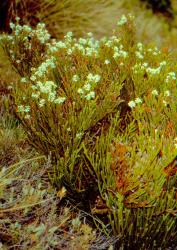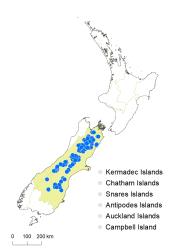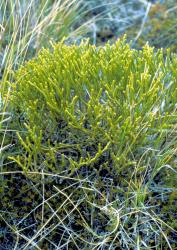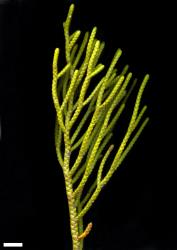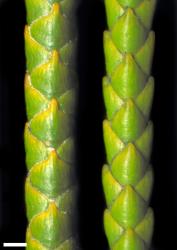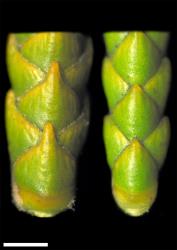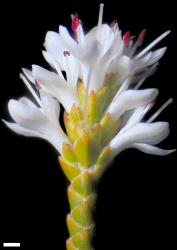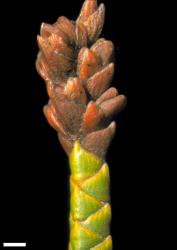- ≡ Hebe lycopodioides (Hook.f.) Andersen, Trans. New Zealand Inst. 56: 693 (1926)
- ≡ Leonohebe lycopodioides (Hook.f.) Heads, Bot. Soc. Otago Newsl. 5: 9 (1987)
- = Hebe lycopodioides var. patula G.Simpson & J.S.Thomson, Trans. & Proc. Roy. Soc. New Zealand 73: 164 (1943)
- ≡ Leonohebe lycopodioides var. patula (G.Simpson & J.S.Thomson) Heads, Bot. Soc. Otago Newsl. 5: 9 (1987)
- ≡ Hebe lycopodioides subsp. patula (G.Simpson & J.S.Thomson) Wagstaff & Wardle, New Zealand J. Bot. 37: 34 (1999)
Whipcord shrub to 1 m tall. Stems decumbent to erect, glabrous except for caducous long, sinuate hairs at connate leaf bases. Leaf bud indistinct, its outer leaves fully grown, diverging. Leaves opposite-decussate, connate in pairs and encircling stem, appressed and usually covering the well-marked node above, crowded and overlapping, scale-like; lamina coriaceous, broadly ovate to deltoid, 1.5–2.5 mm long, 2.0–2.5 mm wide, dull to glossy olive-green or yellowish-green, prominently longitudinally ribbed especially when dry; surfaces glabrous or with an adaxial tuft of tangled hairs at apex; margin glabrous or eglandular-ciliate, entire; apex mucronate, sometimes sub-acute to acute; base broad; petiole absent. Inflorescence a terminal spike, 3.5–20.0 mm long; flowers crowded, 4–20, all bisexual; bracts opposite-decussate, connate, deltoid; pedicels absent. Calyx lobes 4–5 (5th lobe small, posterior), obtuse to acute, sub-equal, 2–3 mm long, ciliolate with mixed glandular and eglandular hairs. Corolla 5–8 mm diameter; tube white, 2.5–4.0 mm long, eglandular-hairy inside; lobes 4, white, sub-erect to spreading, sub-equal, elliptic or obovate, 3.5–5.0 mm long, obtuse to rounded, posterior lobe sometimes emarginate; nectar guides absent. Stamen filaments white, 2.5–4.5 mm long; anthers magenta. Style glabrous, 4–7 mm long. Capsules latiseptate, sub-acute, 2.0–3.4 mm long, 1.3–2.4 mm at widest point. Seeds ellipsoid, flattened, finely papillate, pale brown, 0.9–1.5 mm long.
Veronica lycopodioides is a distinctive species. Among the whipcord group, only V. poppelwellii and V. lycopodioides plants have ribbed leaves, but V. poppelwellii plants differ by their obtuse or sometimes sub-apiculate leaf apex.
Near Lewis Pass, plants of V. lycopodioides may have acute or very shortly apiculate leaves, slender branchlets, and low-growing habit. These have been called Hebe lycopodioides var. patula, but there is no sharp distinction. Some plants from northern localities lack the leaf ribbing or their leaves are only weakly ribbed near the margins, but these can be distinguished from local forms of V. hectorii by their sub-acute to acute apices (not rounded) and more strongly keeled leaves. In Otago, V. hectorii subsp. demissa plants have apiculate to mucronate leaves like those of V. lycopodioides, but these are not ribbed.
In V. lycopodioides and V. poppelwellii the thick leaf veins are close to the abaxial surface and join at their apices to form a marginal vein. In V. tetragona and V. hectorii the veins are also thick, but closer to the adaxial surface and do not join to form a common marginal vein. In V. tetragona and V. hectorii the bracts, but not the leaves, may be ribbed, and then they resemble the leaves of V. lycopodioides, except for being thinner.
South Island: Sounds Nelson, Marlborough, Canterbury, Westland (near the Main Divide), Otago, Southland (northern). A specimen of V. lycopodioides from Mt Dick, Eyre Mountains (AK 107864), included on the distribution map, is outside the normally accepted distribution range of V. lycopodioides and within the distribution of V. poppelwellii and its status remains uncertain. AK 8215–6 from Greenstone Valley has not been mapped, because the location is far west of the known distribution.
Penalpine to alpine grassland and shrubland. Recorded elevations range from 758 to 1830 m.
Flowers: December–February (sometimes November–April); fruits: January– April, persisting all year.
2n = 40 (see Bayly & Kellow 2006, as Hebe lycopodioides).
Veronica lycopodioides is classified in V. subg. Pseudoveronica sect. Hebe and informally in the “Flagriformes” group, also known as “whipcord hebes” (Albach & Meudt 2010; Bayly & Kellow 2006). The strongly ribbed leaves are seen otherwise in only V. poppelwellii , which probably indicates these are sister species, and this is supported by ITS and cpDNA sequence data (E.M. Low, unpublished data).



